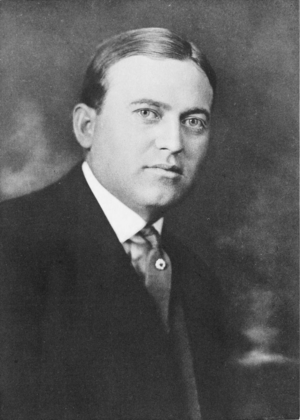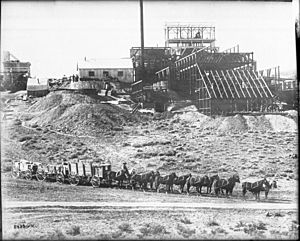George Wingfield facts for kids
Quick facts for kids
George Wingfield
|
|
|---|---|
 |
|
| Born | August 16, 1876 Fort Smith, Arkansas
|
| Died | December 25, 1959 (aged 83) Reno, Nevada
|
| Nationality | American |
| Occupation | Banker and miner |
| Known for | One of the state's most powerful economic and political figures during the period from 1909 to 1932 |
George Wingfield (born August 16, 1876 – died December 25, 1959) was an important person in Nevada's history. He started as a cattleman and gambler. Later, he became a successful banker and investor. From 1909 to 1932, he was one of the most powerful people in Nevada's economy and politics.
George Wingfield moved to Winnemucca in 1899. There, he met George S. Nixon, who later became a senator. Nixon became Wingfield's mentor. In 1901, Wingfield partnered with John Hennessy in the mining town of Tonopah. In less than five years, Wingfield went from dealing cards to becoming the richest man in Nevada.
Contents
Early Life and Family
George Wingfield was born in Fort Smith, Arkansas in 1876. His parents were Thomas Yates Wingfield and Martha Matilda Spradling. When George was five, his family moved to Oregon. There, he learned to be a buckaroo on a ranch in Burns.
George Wingfield married early in his life. After he became wealthy in 1906, his first marriage ended. He then married Maud Azil Murdoch Hamlin, and they had a son, George Wingfield Jr. Later, Wingfield married Roxy Thoma. She was the daughter of a well-known doctor in Reno. Both Roxy and George Jr. are buried next to George Wingfield.
Building a Career
By the time he was 20, George Wingfield was a cattle drover. He moved cattle herds from Oregon and California to Winnemucca. This town was a stop on the Southern Pacific Railroad. It was also known for its saloons and gambling.
In Winnemucca, Wingfield met George S. Nixon. Nixon was a former railroad worker who became a banker. He was 16 years older than Wingfield and became his guide. In 1899, Wingfield stopped working with cattle. He opened a saloon in Golconda, but sold it by 1901.
Success in Mining Towns
Wingfield used the money from his saloon to travel south. He arrived in Tonopah in 1901. Tonopah was a booming town because silver ore had been found there. At first, Wingfield played poker and dealt cards at the Tonopah Club. By 1902, he and John Hennessey took over the club. They quickly made $200,000 in profits.
In October 1902, Wingfield and Nixon became business partners. They invested in mining and real estate. They soon owned the Boston-Tonopah Mining Company and the Nye County Bank. In 1904, gold was discovered near Goldfield. Wingfield moved to Goldfield and bought a saloon. Nixon advised him to focus on more serious investments. So, they bought more land and almost all the mines in Goldfield. In 1904, Nixon became a U.S. Senator for Nevada.
Becoming Wealthy and Facing Challenges
By his 30th birthday in 1906, Wingfield had made a huge fortune. This came from owning mines in Tonopah and Goldfield. He and Nixon started the Goldfield Consolidated Mining Company. It was a public company with $50 million in capital. Wingfield alone was worth $30 million.
In 1907, there were disagreements with workers at their Goldfield mines. The mine owners closed the mines. This meant thousands of miners lost their jobs. It caused many problems and attracted a lot of attention.
New Ventures in Reno
In 1908, Wingfield moved to Reno. He became involved in politics, banking, ranching, and hotels. His partnership with Nixon ended in 1909. Wingfield took the mining businesses, and Nixon took the banks. Wingfield also invested in oil.
After Nixon passed away, Wingfield bought the Golden Hotel in Reno. He also bought the city's other main hotel, the Riverside Hotel. His mining company also gained international interests. Wingfield also went back to his roots. He ran a ranch and dairy farm in Fallon.
Influence and Legacy
After his mentor Nixon died in 1912, Wingfield was offered a Senate position. However, he decided not to take it. He made friends in both political parties. His businesses survived a big fire that damaged Goldfield in 1923.
In the 1920s, Wingfield worked with lawmakers. He helped make Nevada a place where people could get quick divorces. This helped his hotel businesses in Reno. He also worked to make gambling legal. This was against the law in many other states. Because of his efforts, Reno and all of Nevada became popular tourist spots. In 1928, Wingfield was elected to the board of the University of Nevada.
Much of Wingfield's money was lost during the Great Depression. In 1931, he faced financial difficulties. He put up his own money to cover some missing state funds. He later declared bankruptcy. However, by 1935, he was rebuilding his wealth. He invested in the Getchell Mine near Winnemucca. By 1955, he was ready to retire. He sold his security company in Reno and the Riverside Hotel.
Death and Legacy
George Wingfield passed away in Reno on December 25, 1959. His wife and son survived him. They were later buried next to him in Reno. In 1992, he was honored by being inducted into the National Mining Hall of Fame. This is located in Leadville, Colorado.
Wingfield Park in Reno is located along the Truckee River. It was built on land that George Wingfield donated. Also, a new neighborhood called Red Hawk at Wingfield Springs was built. It is on the land where George Wingfield's Spanish Springs Ranch used to be. The developer named it after Wingfield.


